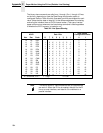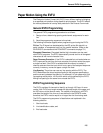
EVFU Example
289
EVFU Example
The following EVFU example is a 2-inch form at 6 lpi line spacing. Thus, 12
lines on the form must be defined. The form is repeated 3 times. Paper
instructions are disabled.
Assign Line Identification Codes
Line ID Code Description Assigned Hex Code
Start Load Start EVFU 1E
Line 1 Top of Form 10
Line 2 Filler 11
Line 3 Filler 11
Line 4 Filler 11
Line 5 Vertical Tab 1B
Line 6 First channel stop 13
Line 7 Filler 11
Line 8 Filler 11
Line 9 Second channel stop 12
Line 10 Filler 11
Line 11 Third channel stop 15
Line 12 Filler 11
Stop Load End EVFU 1F
EVFU Format in Execute Mode
The Execute command shown on the next page, derived from the Execute
command format on page 59, illustrates how the EVFU data above is
incorporated into the Execute command. All other Execute command
parameters are shown in italics. (Optional parameters are shown in brackets
[ ].) Figure 58 on page 291 illustrates the printed output from this data.
The boldface line below the EXECUTE command represents the hexadecimal
EVFU load sequence which identifies the channel codes at which overlay
data will be placed on each form. The example hex values correspond to the
line identification codes listed above. Channel codes not described above as
Filler channels are assigned unique hex codes. Calls to these channels will
print overlay data at specific positions on the form.
The two ~AF lines, also shown in italics, represent the dynamic data. While
the EVFU does not affect dynamic data positioning (data placement is defined
by the ALPHA statement when the form was created), the commands are
shown to specify where they would occur in relation to the EXECUTE
command, the EVFU load sequence, and the overlay data.


















